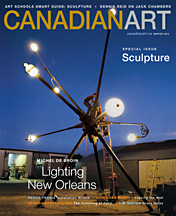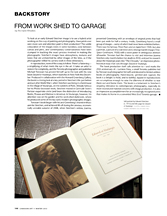



From Work Shed to Garage
By Richard Rhodes
Canadian Art, 2012
By Richard Rhodes
Canadian Art, 2012
To look at an early Edward Steichen image is to see a hybrid artist working on the cusp of painting and photography. Have prints ever seen more care and attention paid to their production? The subtle colouration of the images exists in some transitory zone between canvas and print, and contemporary conservationists have been stumped in tracking the exact process involved in making the photographs. Steichen's images have atmospheres, textures and tones that are unmatched by other images of the time, as if the photographer willed his camera work in three dimensions.
In reproduction, none of this is easy to follow. There's a flattening - a simplifying of what meets the eye in the art. It takes an artist to restore the complexity, and the Toronto photographer and publisher Michael Torosian has proved himself up to the task with his new book Eduard et Voulangis, which launches in New York this December. Produced in collaboration with the Howard Greenberg Gallery, the book is a loving look at a key period in Steichen's life: just before and just after World War I, when Steichen was living in a farmhouse in the village of Voulangis, on the outskirts of Paris. Already famous for his Photo-Secession work, Steichen moved in Gertrude Stein's Parisian expatriate circle (and bears the distinction of introducing Rodin, Picasso and Matisse to America). In Voulangis, however, his attention was on his garden and his work-shed darkroom, where he produced some of the key early-modern photographic images.
Torosian's book began with his and Greenberg's shared enthusiasm for Steichen, and achieved lift-off during the anxious, economically unstable autumn of 2008, when Steichen's widow, Joanna, presented Greenberg with an envelope of original prints that had been put aside for half a century. Inside, Greenberg found a small group of images - some of which had never been exhibited before. There was the famous Three Pears and an Apple from 1920, but also a portrait, a picture of a coal stove and a strange backlit image (Time-Space Continuum, 1920) with a stove poker in ambiguous abstract silhouette. Torosian had the chance to visit and interview Joanna Steichen only months before her death in 2010, and put his research about the Voulangis years into "The Chrysalis," an impressive photo-historical essay that runs through Eduard et Voulangis.
The book production itself calls attention to - and marks the 25th anniversary of - Lumiere Press, a small Toronto publisher led by Torosian (a photographer himself) and devoted to limited-edition books on photography. Hand-bound, -printed and -typeset, the book is a delight to hold, and its faithful, tipped-in reproductions are scrumptious enough to raise the dilemma of whether to tear them out and frame them. The book is a testament to Steichen's ongoing relevance to contemporary photography, especially its more visceral and material concerns with image production. It is also an impressive accomplishment for an increasingly recognized press that makes its home in a converted West End Toronto garage.